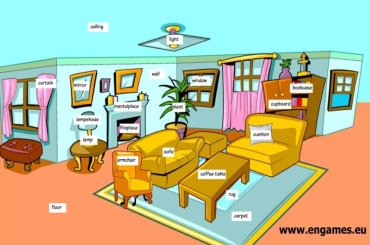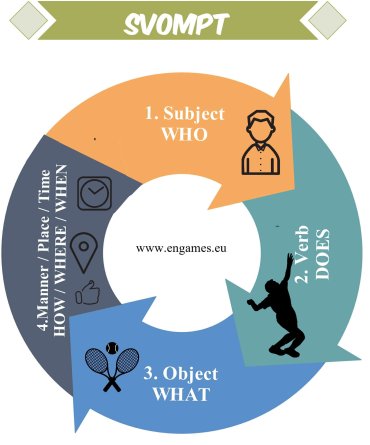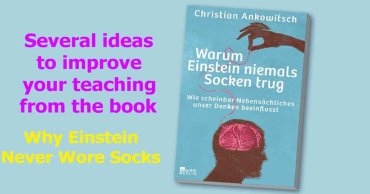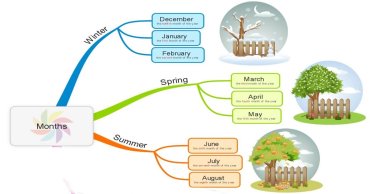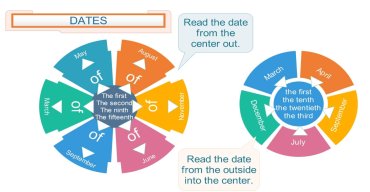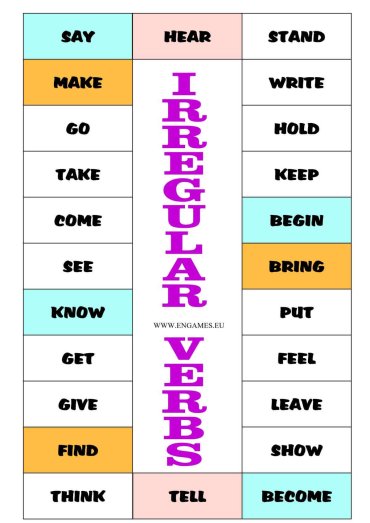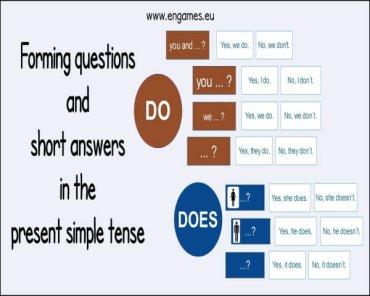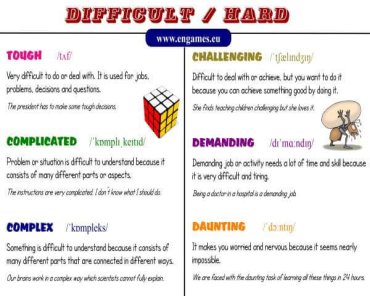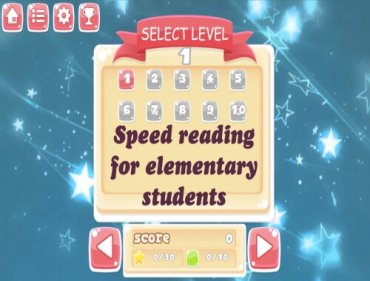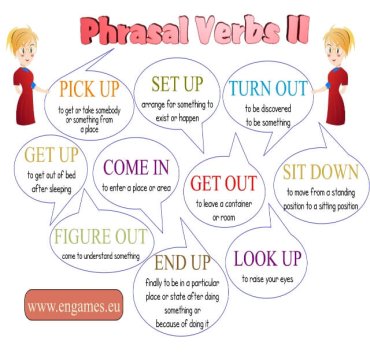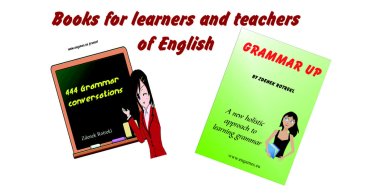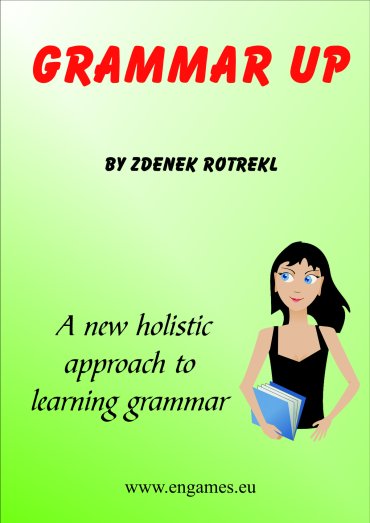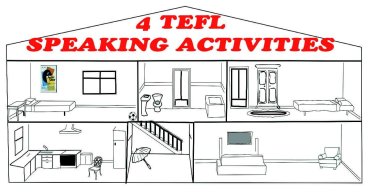“He must be joking!” I thought. I was shocked but I kept quiet. My friend Jane didn´t.
“Why the hell should I throw all my work away?” she asked. We went silent and expected that Jane will be punished.
(more…)The SVOMPT rule is the most important rule in English. As there are very few declinations in English, the word order rule is the one that keeps the sentences understandable. If you do not apply this rule, your sentences will make no sense.
<!– wp:more –>
Unfortunately, there are very few textbook that teach this grammar explicitly. For example, I teach the textbooks Happy House, Happy Street, Project, Inside Out and Headway and none of them teaches SVOMPT. The rule is taught only implicitly. But I think that this is so important that you need to teach it explicitly. Thus, if your textbook fails to do so, set apart two lessons and teach this rule.
ADVERT:
[showmyads]
To make your work easier, you will find an infographic and a worksheet which you can use in your lessons here.
SVOMPT – explanation
To explain the basic rule you can use the following infographic which I published several years ago. It is nice and comprehensive but for some students it might be a bit overwhelming. (You can find the whole post on SVOMPT here.)
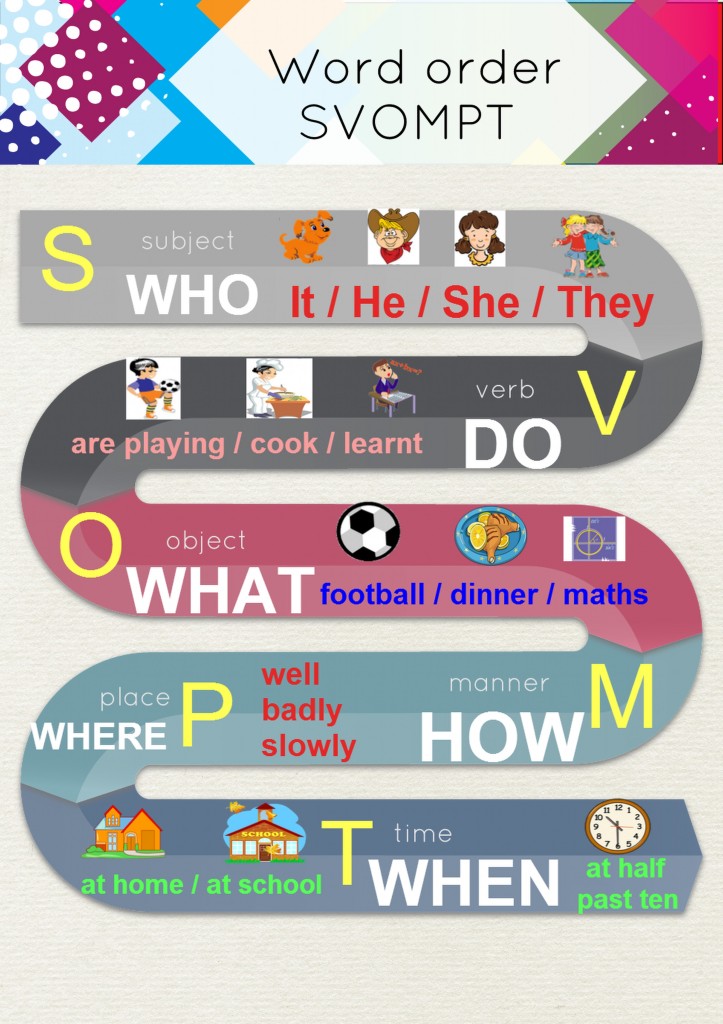
This time I try to make things a bit easier and I created the following infographic.
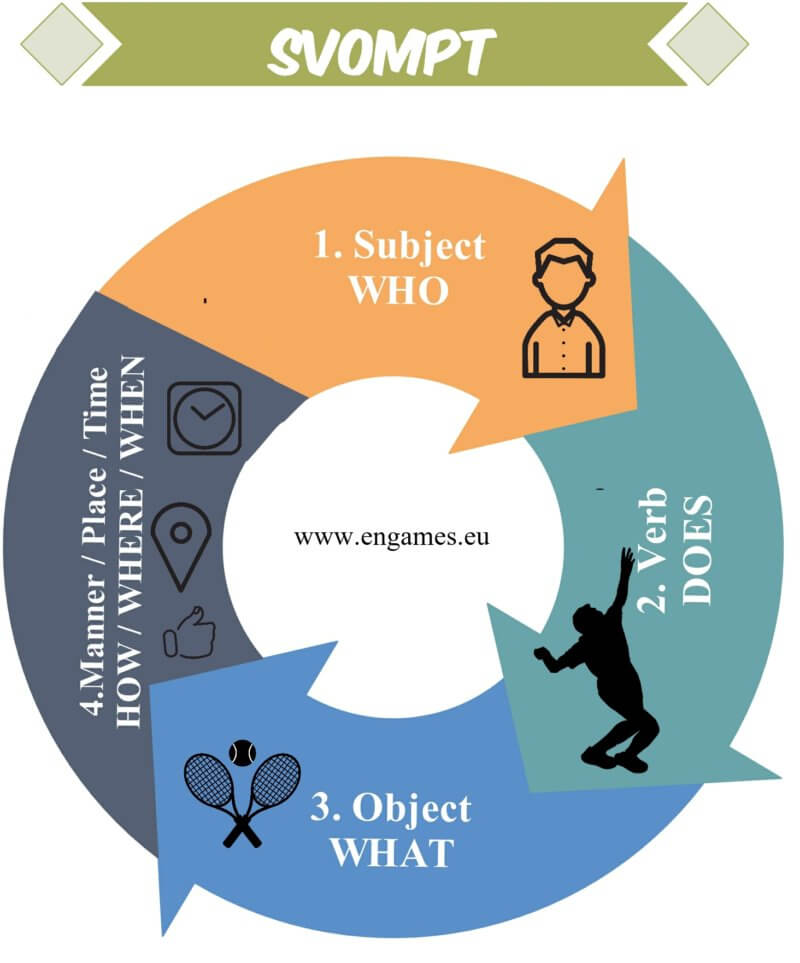
When explaining the rule, emphasize that you cannot leave out the subject. You have to express it and it has to be followed by the action that the subject makes. After the action object follows. Object is the thing that has been somehow affected by the action. Then the adverbs follow.
Students have to remember that each sentence has to contain the SUBJECT and VERB. The other parts might or might not be there.
SVOMPT worksheet
To practise the grammar, here is a worksheet with three exercises.
In the first exercise, students circle the sentences that are correct. You might use the exercise before the explanation.
In the second exercise, students place the word in brackets into the correct position.
In the third exercise, students put the words into the correct order.
In the last exercise, students write sentences about the animals, using the words in the pictures.
Category: English games
At Christmas I got and read a book by Christian Ankowitsch called Warum Einstein niemals Socken trug (Why Einstein Never Wore Socks). The author collects all the pieces of research that show how our physical behaviour influences our thinking. There are many interesting facts that you may find useful in your daily life. But can it help my students?
<!– wp:more –>
ADVERT:
[showmyads]
Yes, it can. If students do some things, they will boost their learning. So I noted down all the ideas to apply at school and I would like to share them here with you.
Better teacher!
How can you be a better teacher? You should study, take a lot of courses and work hard. Sure. But actually, there are a few simple things you can do right now!!!
First, stand straight and tall, and your students will respect you more. They will listen and they will not disturb so much.
Second, keep your classroom tidy and cosy and your students will behave better. Moreover, if you add a pleasant smell that students associate with cleanliness, they will cause fewer problems.
Third, smile and the world smiles with you. Activate the muscles that you use for smiling and you will feel better. And it works for your students too. Make them smile, and they will feel better in your classes. For example, you could ask them to take a pencil into their teeth in such a way that their lips do not touch it. Then they can look around and they will feel better. Curiously, people feel actually better just by activating facial muscles.
Fourth, do you want your students to listen to you? Make them lean forward and spread their arms. People simply take in more if they are in this open position. On the other hand, if they lean back and cross their arms in front of them, you just waste your time. They are closed and the amount of information they receive is small.
Better students!
Do you teach a foreign language? Use a lot of gestures and pronounce clearly. Let your students use gestures. However, be careful to use appropriate gestures. If you use unsuitable moves, your students will be confused.
Most important things shall be placed in the middle of your lessons. If a lesson is 45 minutes long, students remember best all the things that happened between the 15th and 30th minute. Unfortunately, they do not remember much from the beginning of a lesson, so use this part of revision.
To improve your students listening skills, allow them to doodle. Those who doodle listen better.
Let your students chew a chewing gum! Really! But never during a lesson. If they chew five minutes before the lesson starts, their thinking process will improve and they will concentrate more.
Do not allow your students to throw away their notes from a lesson. If they do, their mind will discard the information they learnt, too. In my classes, students often leave their exercise books at home, and they write on a piece of paper. Then they leave the paper behind and their knowledge with it. I will not allow this again! We remember what we write down and carry away.
When you want your students to learn by heart, ask them to hold something in their right hand. A paper tissue is a good solution. They can make a ball out of it. Through this, they will remember the things they learn more easily. And when the students are tested, they should hold something in their left hand. Then the brain retrieves the information more easily.
And last but not least, do not let your students sit at the back of your classroom. Students who sit at the back, get worse scores in their tests. If you seat a bad student in the middle of the classroom or at the front, chances are, that his performance will improve.
A few more facts
Have you ever heard about “clothed cognition”? Do not worry. I haven´t heard about it either. But this says that students behave differently if the clothes they wear are associated with a certain behaviour. For example, a young boy wearing his favourite Superman T-shirt. will get a higher score in his test than normally. Students wearing clothes doctors usually wear, will give their work more attention.
Singers are better at languages than others. Singing activates the same parts of the brain that are necessary for learning a language. And the active brain is the learning brain.
Do you believe that if you ventilate your aggression, you will calm down and behave better the next time? NO! On the contrary. If you do not regulate your behaviour it will be worse the next time.
And it might be a good idea to teach vocabulary in a gym. Students riding a bicycle trainer learnt more words than those sitting in a classroom.
Conclusion
The facts above are in the book Why Einstein Never Wore Socks. There are many more facts in this book, but these are not that easy to apply to a classroom. I can certainly recommend this book.
Months are one of the few lexical sets that students have to learn. In general, lexical sets are difficult to learn and remember. Therefore, we should teach vocabulary in thematic sets. However, there are a few exceptions to this rule. There are some lexical sets which should be taught as such. They are for example numbers, days of the week and months.
<!– wp:more –>
In this post, I am going to offer you several activities to help your students learn all of the months. There is a video, an infographic, a worksheet and a speaking activity.
ADVERT:
[showmyads]
Months – song
Whenever I teach months of the year, I start my lesson with the following song by British Council. It is catchy and it is a great way to introduce the months.
Ask the students to sing along and then introduce the following infographic.
Infographic
Display the following infographic:
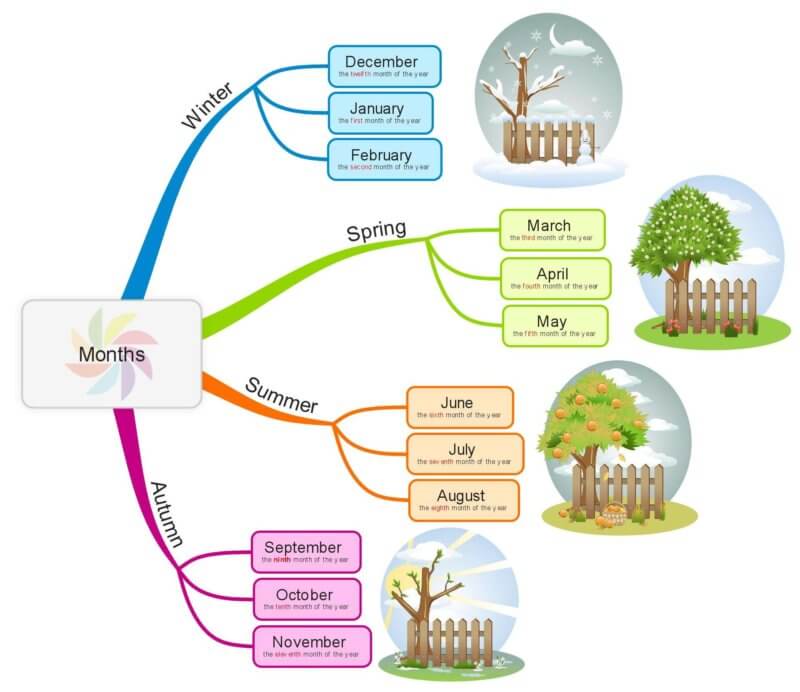
It is a good idea to print the infographic for everyone, so they can take it home. You can print it from the following pdf file.
Months of the year – infographic
Past simple and continuous – song
To practise the vocabulary, download the following worksheet, and print it for everyone. Ask the students to solve the puzzles. It usually takes them about 15 minutes to finish all the tasks. You do not have to check their answers, as it is not possible to finish the tasks while you give wrong answers.
Months of the year – Speaking activity
The following speaking activity is called pair crossword.
- Divide the class into Group A and Group B.
- Explain that you are going to give both groups the same crossword but that group A will have the across words already written in and group B will have the down words already written in. Their task is to write clues for the words written in their crosswords.
- Give a copy of crossword A to each student in Group A and a copy of crossword B to each student in Group B.
- Students work in their groups and write the clues.
- When they have finished writing their clues, the students should work with a partner from the other group. They must not sow their crossword to their partner.
- They sat facing one another and take it in turns to ask their partner for clues to the missing words on their own crossword. They should read out the clues they have written for their partner to guess the words, and write in the missing words on their crosswords from the clues their partner gives them.
I can see what you think. Irregular verbs again? You must be joking!!!
I know. I have already published many posts on irregular verbs. For example:
<!– wp:more –>
ADVERT:
[showmyads]
But let´s be honest. None of them proved to be the miracle solution which would make my students learn all the verbs.
In fact, after all those years of teaching, I have come to a conclusion that there is just one way to ensure that students learn something. They have to LEARN it. I, as a teacher, can motivate, explain and navigate, but only the students can learn.
And that is why I decided to write this post. Here, I would like to share with you a simple vocabulary trainer which will help your students learn the past tense of 50 irregular verbs in English. If they learn these fifty (in fact there are 52, but fifty sounds so much better 🙂 ) they will understand 87% of all occurrences of all irregular verbs in English.
Needs analysis
To know the irregular verbs, students need to learn the following. They need to memorize the meaning of the verb, the infinitive and the past tense of each verb. The easiest and quickest known way to do this are word lists and flashcards. If you doubt my words, have a look at anything written by Paul Nation.
However, as we live in the twenty-first century, paper is not something that our student would be fond of. Especially teenagers seem to be allergic to it. But they never fail to have their mobile on them. Thus, if we could get into their mobiles, they might start learning.
Thinking along these lines I decided to make a mobile app that would work a bit like the flashcards, and which would provide the meaning, the infinitive and the past tense of the verb. Moreover, if the students finish the game, they will meet each verb between six and eighteen times which should ensure they remember them.
You can see the app below:
Learn 50 Irregular verbs – full screen
And you can download the app here:
Learn 50 irregular verbs – App store
Irregular verbs past tense – Italian version
Irregular Verbs – Invitation to collaborate
As you can see, the application is perfect for Czech students but not of much use for anyone else. That is why I would like to ask you for help. Could you translate the past tense of the 50 irregular verbs and send them to me? If you do, I will publish the app place a link here and your students will be able to use this app too.
The app will be free and there will be a web version too.
You can download the word file here.
Please, send the resulting file to my email rotreklzdenek@gmail.com. Thanks.
It is very important for students to be able to say and understand dates in English. For example if our students deal with someone about a deadline, they need to be sure what date is being talked about. In business, missing the deadline can have dire consequences. Therefore, dates are extremely important for the students to learn.
<!– wp:more –>
I have already published some materials on this topic. There is a post on dates here. But as I was not really happy with my students´ progress in this area, I created several new materials and I was pleased to see how well they worked in my classes. That is why I will share them here and I hope they will be as successful in your classes as they were in mine.
Dates – months
To be able to form dates, students have to know the months.
I always start with the following song by British Council:
Ordinal numbers
Another thing your students need to know before they can form the dates, are the ordinal numbers. Display the following infographic. Explain that the students have to learn the numbers 1-3 by heart. Then explain that it is enough to add the ending -th. However, they have to be careful with the spelling of the numbers in the green field. Numbers above 20 are explained in the last field.
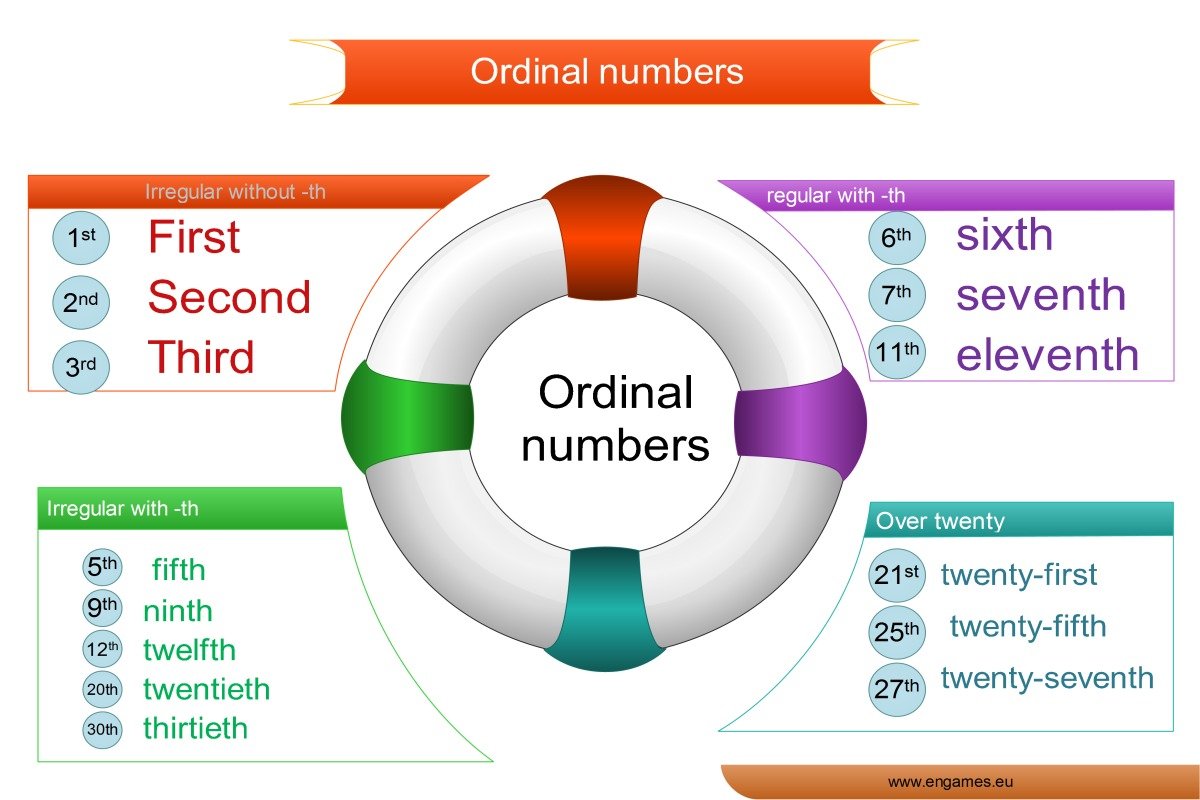
Play the following video and ask the students to repeat the numbers.
Dates – infographic
Once the students know the months and the ordinal numbers, it is time to teach them how to form the dates. Display the following infographic:
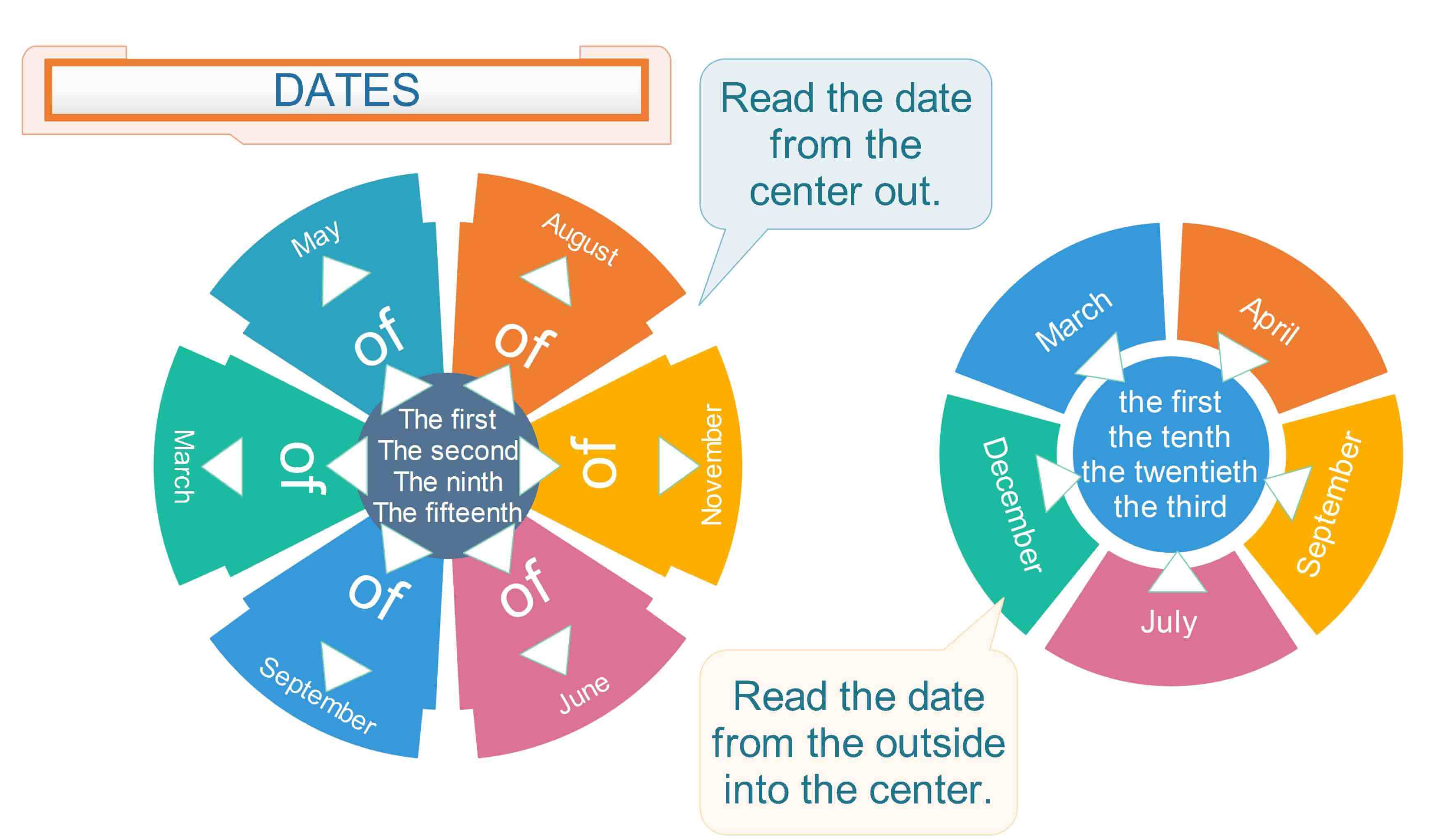
Explain that in English there are two ways to say a date. You can use either the way displayed on the left, where you start from the centre and move outside. Thus the resulting date is THE ORDINAL NUMBER OF MONTH.
Or they can choose the other way of saying the date. It is depicted on the right and students start from the outside and move to the centre. The resulting phrase then is MONTH THE ORDINAL NUMBER.
Bingo
First, try the following dictation. Students listen and write the dates they hear. The correct results are displayed at the end of the video. If you see that your students struggle, it is a good idea to play the video twice and pause the recording after each date.
I found out that Bingo is a great way to practise dates. Print the following worksheet and cut it into cards. Give each student a card. Explain the rules and set the winning combination. I usually say that the winner needs two columns. Then you call one of the students and he or she says a date from their card. Then you call another and so on.
In the issue 105 of English Teaching Professional there is a wonderful article by Chris Payne. It is called Plan V and it deals with vocabulary teaching. Chris explains that teachers should teach vocabulary every lesson, they should teach high frequency words and they should not teach semantic sets. He supports his arguments with research and the whole text is really worth reading.
<!– wp:more –>
For me, the most important idea to teach thematic sets instead of semantic sets. Research shows that it takes much longer to learn words in semantic sets than it takes to learn unrelated vocabulary items. However, “it was found that grouping words according to a theme, so long as they belong to a different class, can aid retention and enhance learning…” (Chris Payne, English teaching professional issue 105). Therefore, teachers should teach thematic sets instead of semantic sets.
ADVERT:
[showmyads]
What is the difference between a semantic and thematic set? An example of a semantic set is for example the category clothes. Words like jumper, skirt, shirt, trousers, gloves, T-shirt etc. create a semantic set. A thematic set are the words used for a given theme. Thus a thematic set for a frog, consists of words swim, green, hop, pond, croak and slippery. And these thematic sets are much easier to learn.
However, if you start to search the internet, you will find that these thematic sets are very difficult to find. That is why I would like to create and publish several such sets here.
Birthday
All the words in the Birthday set were chosen in the following way. There can be only two words which are the same part of speech. Therefore, there are only two nouns, two verbs and two adjectives. These words are then organised into a mind map and their meaning is illustrated.
Under the mind map you can find example sentences. It might be a good idea to read the sentences with your students aloud to practise the pronunciation.
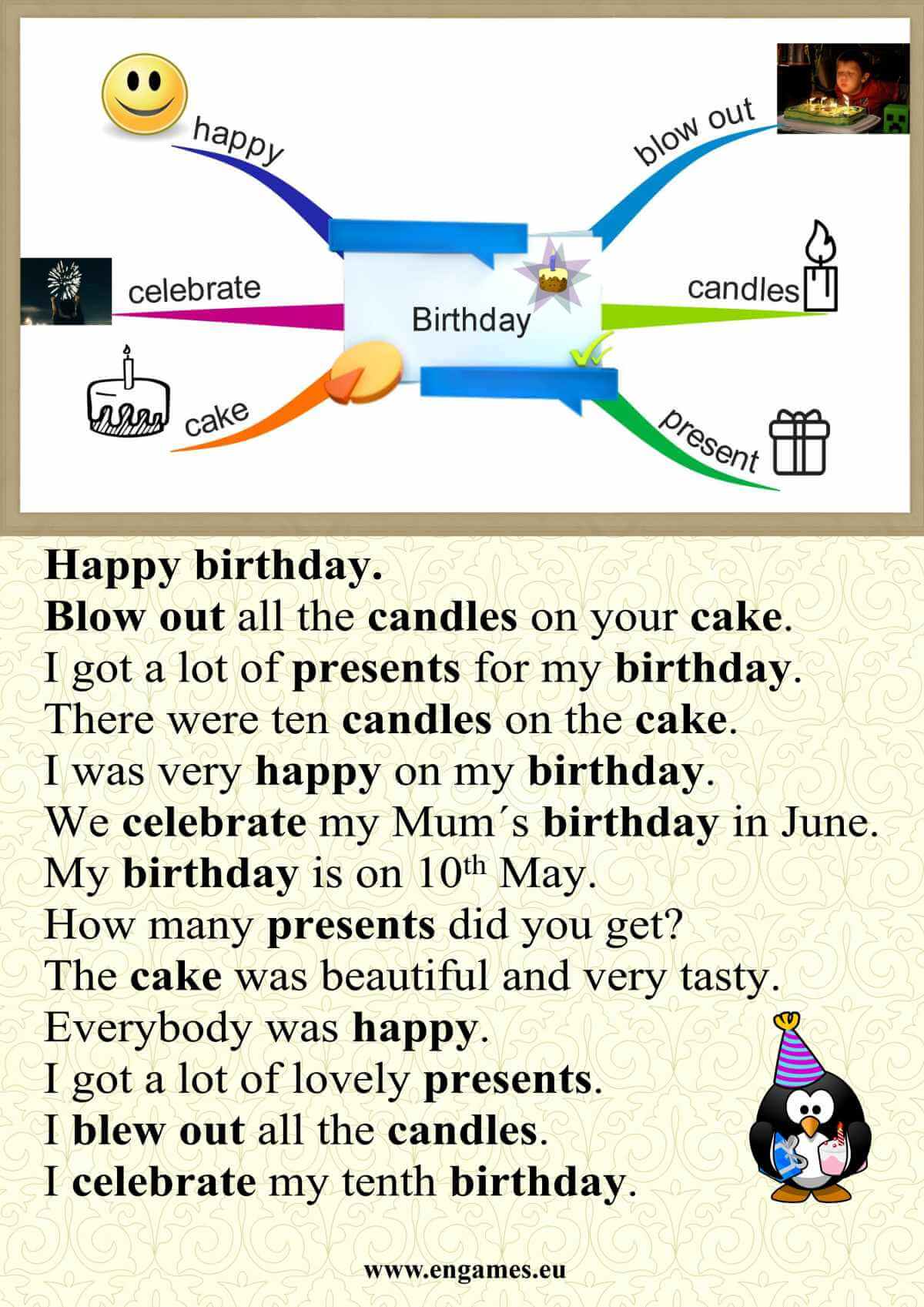
On the second page, there are two exercises for the students to practise the vocabulary. In the first task, students read the sentences and complete them with the words from the mind map.
In the second exercise, students should read the sentences aloud, replacing the pictures with the appropriate words.
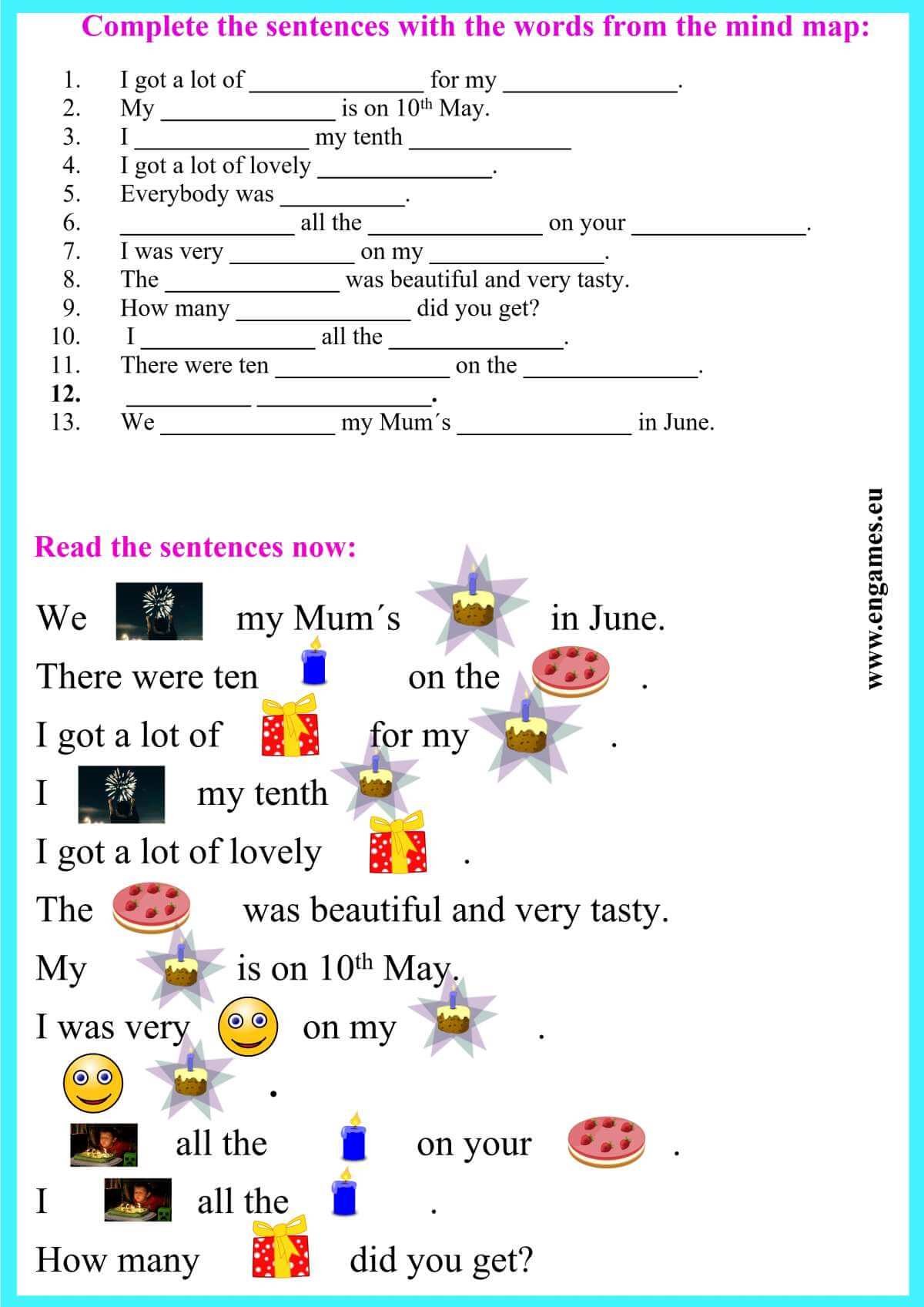
You can download the pdf file with the worksheets here:
Pdf worksheet
Do you think these thematic sets are useful? Vote here:
Do you think these thematic sets are useful?
Dictation is one of the best listening activities. To be able to write what you hear, you have to understand it and know the words. Once you can divide the stream of sounds into separate words, then you can understand it. And as dictation makes you do this, it is the best way to improve your listening skills.
<!– wp:more –>
ADVERT:
[showmyads]
In this post there are three dictations. The first dictation is for elementary students, the second is for lower-intermediate and intermediate students and the third one is the most difficult. These exercises should be used to practice listening at home or on students mobile phones.
Moreover, each exercise is offered as an MP3 recording where each sentence is repeated three times. You can use these recordings at school for your students to practice their listening.
Elementary
Students can practise their listening in the following online quiz.
If you want to use the exercise at school here you can play the recording for elementary students. At the end of the exercise there are all the sentences written and your students can check their answers on IWB.
Pre-intermediate dictation
Pre-intermediate students can practise their listening in the following online quiz.
If you want to use the exercise at school here you can play the recording for Pre-intermediate students. At the end of the exercise there are all the sentences written and your students can check their answers on IWB.
Intermediate
Intermediate students can practise their listening in the following online quiz.
If you want to use the exercise at school here you can play the recording for intermediate students. At the end of the exercise there are all the sentences written and your students can check their answers on IWB.
Irregular verbs in English are very important for students to learn. These verbs belong among the most frequent words in English and if you want to speak about your experience you cannot do without them. Therefore it is extremely important to give a lot of time to teaching and learning these verbs.
<!– wp:more –>
To make the learning easier, teachers should offer interesting and fun activities. At www.engames.eu you can find a lot of activities to teach the irregular verbs. For example:
All of the activities above will make teaching and learning the irregular verbs easier.
ADVERT:
[showmyads]
I have already published many activities but this time I come with something new.A board game. The game is called Catch me!(if you can). The rules are simple and the preparation time is low. The game is fun and students have to produce all the irregular verbs.
Catch me!! – resources
To play this game, you need to print the game and the key for each group of students.

Moreover, you need the key:
Irregular verbs board game – key
And you can print the game from the pdf file.
Irregular verbs – board game
Irregular verbs board game – rules
This game is for up to five players. To play the game, each student needs a counter. Each group needs the game and a key.
Each player places their counter on one of the coloured squares. If there are just two players they place their counters on the pink squares. If there are three players they place their counters on the blue squares and when there are 4 players, they place their counters on the blue squares. If there are five players, one of the players is a referee.
Students decide who will start. The last player takes the key and serves as a referee for the first move.
The player one moves counterclockwise and he/she has to say the past tense and the past participle of the verb in the square in front of him. If he or she does this correctly (the referee decides), he/she moves to this square. The player goes on like this till he/she makes a mistake. Once they make a mistake, the referee tells the player the correct answers and the player stops on the square in front of the square with the verb he/she did not know.
Player one now takes the key and player two tries to move on in the same way. Players take turns after they make a mistake.
The aim of the game is to catch the others. Once a player gets to a square someone is standing on, they catch the player and take them out of the game.
You can change the aim and say that the winner is the student who returns to the square where they started first.
Irregular verbs – other resources
You can find more interesting activities at British Council site.
And of course there is the wonderful song by my friend Jason.
In this post I would like to share 7 online quizzes to practise the present simple tense. All the quizzes are in HTML 5, so you or your students can play them on their mobile phones. Moreover, if you have a website or a wordpress site, you can easily enter these exercise there by copying the code under the quizzes.
<!– wp:more –>
ADVERT:
[showmyads]
Present simple – affirmative
In the first two quizzes, students can practise forming the affirmative statements in the present simple tense. In the first quiz they have to put the verb into the correct form.
To play the quiz on the full screen, click the button below:
To put this quiz on your website or wordpress site, just copy the following code:
<iframe width="710" height="480" src="https://engames.eu/Present simple/Quizzes/Present simple affirmative (Web)/index.html"></iframe>In the second quiz, students test their knowledge of the third person singular.
To play the quiz on the full screen, click the button below:
To put this quiz on your website or wordpress site, just copy the following code:
<iframe width="710" height="480" src="https://engames.eu/Present simple/Quizzes/Present simple affirmative third person (Web)/index.html"></iframe>Present simple – Negative sentences
In the following quiz, students are asked to make the sentences negative.To play the quiz on the full screen, click the button below:
To put this quiz on your website or wordpress site, just copy the following code:
<iframe width="710" height="480" src="https://engames.eu/Present simple/Quizzes/Present simple negative (Web)/index.html"></iframe>Present simple – Questions
In the following quiz, students practise forming questions in the present simple tense.To play the quiz on the full screen, click the button below:
Questions in the present simple tense
To put this quiz on your website or wordpress site, just copy the following code:
<iframe width="710" height="480" src="https://engames.eu/Present simple/Quizzes/Present simple questions (Web)/index.html"></iframe>In the fifth quiz, students can test their knowledge of the short answers in the present simple tense:
To play the quiz on the full screen, click the button below:
Questions and short answers in the present simple tense
To put this quiz on your website or wordpress site, just copy the following code:
<iframe width="710" height="480" src="https://engames.eu/Present simple/Quizzes/Present simple questions (Web)/index.html"></iframe>Present tense – Revision
To revise everything students have learnt about the present simple tense, there are two quizzes to do this.
In the first one, students have to tick all the sentences, that are grammatically correct.
To play the quiz on the full screen, click the button below:To put this quiz on your website or wordpress site, just copy the following code:
<iframe width="710" height="480" src="https://engames.eu/Present simple/Quizzes/Present simple choose correct (Web)/index.html"></iframe>And in the last exercise, students try to choose the correct answer for each gap.
To play the quiz on the full screen, click the button below:
To put this quiz on your website or wordpress site, just copy the following code:
<iframe width="710" height="480" src="https://engames.eu/Present simple/Quizzes/Present simple questions and affirmative (Web)/index.html"></iframe>
In this post, I would like to share the best activities I know to teach questions in the present simple tense. The aim of these fun activities is to help your students form the YES/NO questions and short answers correctly. I have used all these activities in my classes and they worked very well.
(more…)In this post, I would like to share the best activities I know to teach questions in the present simple tense. The aim of these fun activities is to help your students form the YES/NO questions and short answers correctly. I have used all these activities in my classes and they worked very well.
(more…)In English there are many words which have the same or very similar meaning. Words that have the similar meaning are called synonyms. In this post, I am going to present synonyms for the words DIFFICULT and HARD.
<!– wp:more –>
In this post, there are two quizzes to practise the new vocabulary and an infographic explaining the meaning of the words.
ADVERT:
[showmyads]
Difficult and Hard – infographic
The words DIFFICULT and HARD have a similar meaning and you can use the word HARD instead of DIFFICULT nearly all the time (BUT you cannot use DIFFICULT instead of HARD!!!) However, in English there are many other words which are used instead of the word DIFFICULT. You can see them in the infographic below. The meaning of each word is explained and the usage is demonstrated in a sentence.
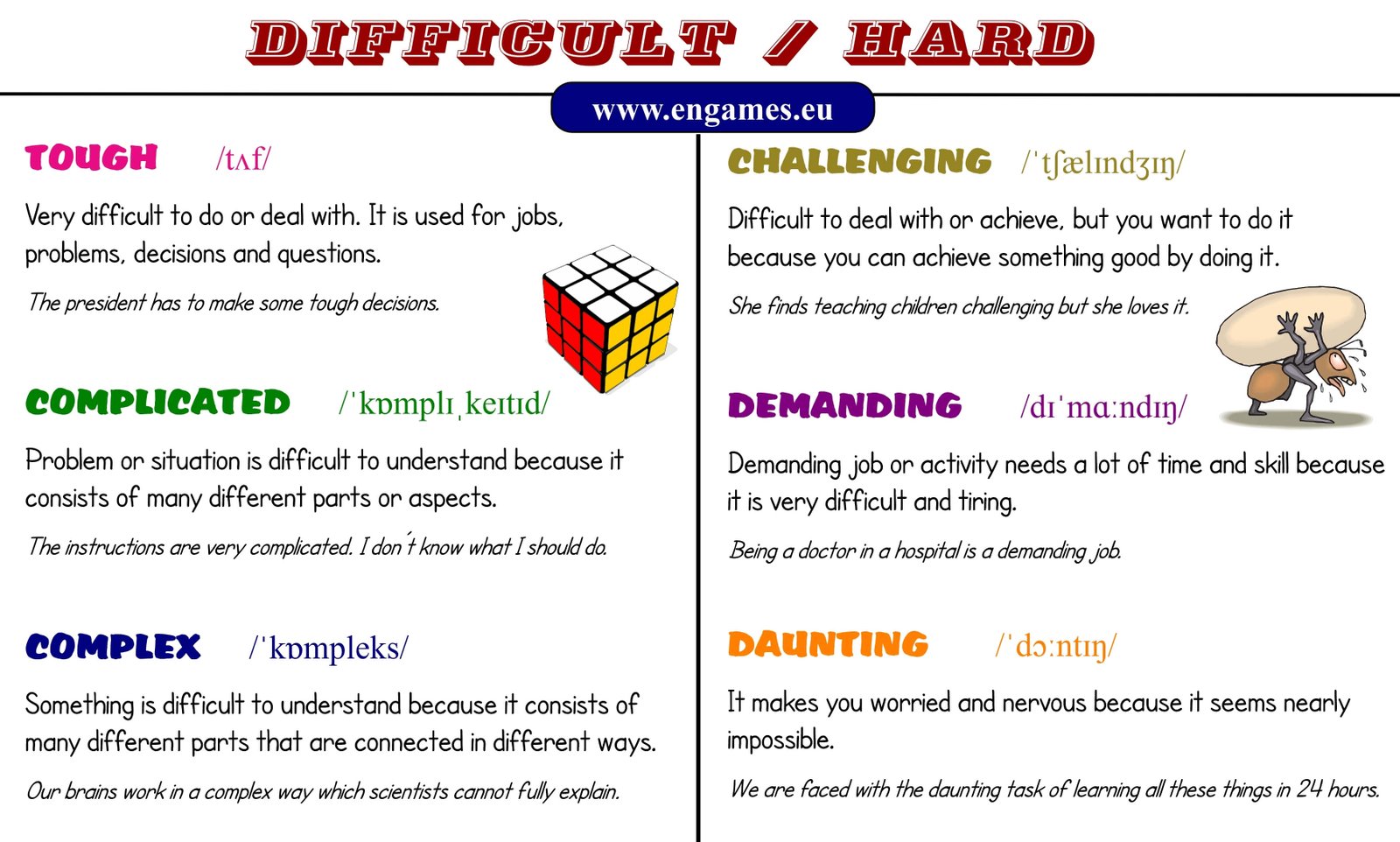
To display the image on the full screen, right-click the picture and open it in a new window. You can print the image then, too.
DIFFICULT and HARD – Quiz
You can test your knowledge of the vocabulary in the following two quizzes. The first quiz consists of three parts. In the first part, you should unjumble the words and type them. In the second part, you have to choose the correct definition for each word. In the third part, you have to complete the sentences with the right words. The quiz is in HTML5, so it will play on all desktops and mobile devices.
The first quiz serves as a way to practise the vocabulary. The second quiz is different. At the end, you will be asked to supply your name and your result will be displayed in a leaderboard.
The quiz consists of two parts. In the first part, you see a definition and you have to type the correct word. In the second part, you see a sentence and you have to type the missing word. Good luck and share your results please.
[WpProQuiz 19]
[WpProQuiz_toplist 19]
Speed reading activities are very important for learners of English. By trying to read quickly, they develop their comprehension and fluency in reading in a foreign language. Thus they improve their knowledge of English.
The problem with speed reading activities is, that they are not for elementary students of English. The texts mostly aim at advanced or intermediate students. To fill this gap, I created a speed reading application and filled it with texts for elementary learners of English.
ADVERT:
[showmyads]
Speed reading – application
Here is the speed reading application. Choose a level and read the text as quickly as possible. When you finish, click the FINISH button and then decide whether the statements are TRUE or FALSE. The final score is your speed. The speed is given in number of words per minute. Thus if you see SCORE 215, it means that your read 215 words per minute.
You can play the game on the full screen here:
Speed reading for elementary students
This is the beta version of the speed reading application. If you spot a mistake or it works badly, please leave a comment and inform us. Your comments are very important, because I would like to publish this for mobile phones and it is nearly impossible to correct the bugs then.
I hope you will find this application useful.
Share your results in the comments, so you can compare with other students of English. If you get over 200 it is very good and you will get three stars.
A few years ago Jason better known as Fluency MC, came up with a rap song and a video. In this video he teaches ten phrasal verbs. And as I like the video very much and I think it is really useful, I decided to create a post using the video.
<!– wp:more –>
In this post you will find the rap song, an infographic and a game to practise and learn the phrasal verbs.
ADVERT:
[showmyads]
Phrasal verbs – video
Play the following video for your students and let them sing along.
If you want to set a task for your students to do during the video, here are two suggestions:
a) Ask your students to write down all the phrasal verbs they hear.
b) Ask your students to count the number of phrasal verbs they hear.
Phrasal verbs with Fluency MC – infographic
Having watched the video, it is time to learn the phrasal verbs. Display the following infographic for your students:

You can download the pdf file here:
Infographic pdf file
If you teach a monolingual group and you speak their language, elicit the translations of the phrasal verbs.
If you cannot translate the words, ask the students to demonstrate the meanings.
All the verbs in the video are easy to demonstrate, therefore once your students finish studying the verbs, practise them using TPT. First, say the phrasal verb in English and students have to demonstrate it. Second, demonstrate and students have to say the phrasal verb in English.
Phrasal verbs with Fluency MC – game
The game is called Darts Quiz Game. Your task is to type the correct answer – the appropriate phrasal verb – and then stop the dart in such a place to get as many points as possible. You can buy and edit the game here.
More posts
Together with Fluency MC we have published quite a lot of posts already. You can see them here:
- Irregular verbs with Fluency MC
- Irregular verbs with Fluency MC 2
- Irregular verbs with Fluency MC 3
- Irregular verbs with Fluency MC 4
- Phrases with GET
- Phrases with GET 2
[wp-review]
Yesterday I published a post in which I taught 16 phrasal verbs which belong among the 50 most frequent phrasal verbs in English. In this post I am going to introduce 10 more phrasal verb which belong into the same category.
Paul Nation in his book What Should Every EFL Teacher Know suggests that every language course should consist of four strands: Vocabulary development, Extensive input and output, grammar explanation and fluency development. By giving these four strands equal amount of time in EFL lessons, students will learn the foreign language.
<!– wp:more –>
 In this post, I will concentrate on speed reading which belongs into the fluency development. If you cannot use the language with some degree of fluency, you cannot claim (and feel) that you know the foreign language. Moreover, fluent reading is essential for successful comprehension. And to achieve it, you need to train it.
In this post, I will concentrate on speed reading which belongs into the fluency development. If you cannot use the language with some degree of fluency, you cannot claim (and feel) that you know the foreign language. Moreover, fluent reading is essential for successful comprehension. And to achieve it, you need to train it.
In this post, you will find a short game for elementary students of English to measure their reading speed. In the future, I plan to publish several more speed reading texts for elementary students, and a mobile phone app.
ADVERT:
[showmyads]
Speed Reading
It is important to read quickly in a foreign language because “by reading quickly, students are training themselves to process meaning chunks. Reading quickly
encourages guessing from context and ignoring unknown words.” (Paul Nation)
To practise this skill, I prepared the following game. Click the button below and start reading as quickly as you can. When you finish, click the orange button “FINISH”, and answer the comprehension questions. Answer the questions as well as you can because your score will be reduced if you make a mistake.
Read the text just once!!! If you do it twice or several times, your results will go up and they will not show your real reading speed and comprehension.
Please, share your results in the comments below. You do not have to sign your results, just write the number of words per minute, you have achieved.
I hope you find this activity interesting and useful. Please, let us know.
Ever since I was a boy I wanted to write and publish a book. It took over thirty years for my dream to come true.
In this post I would like to introduce the three books for learners and teachers of English which I published.
<!– wp:more –>
ADVERT:
[showmyads]
Grammar Up!!
 Grammar Up is a book for learners of English who would like to improve their Grammar.
Grammar Up is a book for learners of English who would like to improve their Grammar.
This book contains 17 short texts which you read and then you check your comprehension.
In the second step you see the text again but this time half of every second word is deleted. So for example you would see a sentence like this:
In t____ second st____ you s_____ the te______ again b____ this ti_______ half o____ every sec____ word i___ deleted.
Your task is to read the text again and complete it.
In the third step, you see a text in which all the verbs are in the infinitive form, all the prepositions are replaced by a dash (-), and all the articles are replaced by an asterisk (*). The text then looks like this:
– * second step you SEE * text again but this time half – every second word DELETE.
Your task is to read the text again and add all the missing words and forms. It might not be a bad idea to write out the text as well.
I think this kind of exercise is very useful and it will help you improve your grammar.
You can find more information about the book Grammar Up and a sample chapter here.
444 Grammar Conversations
 444 Grammar Conversations is a book for teachers of English. In this book you will find over 450 questions which are divided according to the grammar used there.
444 Grammar Conversations is a book for teachers of English. In this book you will find over 450 questions which are divided according to the grammar used there.
My aim was to create a book with a set of questions for each grammar point. The teacher just comes and copies the questions and hands them to students. Students work in pairs and ask and answer the questions practising the grammar.
Here is a set of questions for present simple tense (not included in the book):
1. Where do you live?
2. What do you do?
3. What do you do at the weekend?
4. What food do you like?
5. When do you get up?
6. What music do you like?
7. What do you do after school?
8. What does your mother do?
9. What does your father do?
10. When do you go to bed?
11. What do you do on your mobile phone?
12. What do you want to do on holiday?
13. Do you like English?
14. What sports do you play?
15. Do you like English?
16. What do you do with your parents?
444 Grammar Conversations at Amazon
High School Stories
My last book is called High School Stories, and it contains three stories in simple English. The stories are for pre-intermediate and intermediate students and they will appeal to teenagers.
Here you can see a part of the story called Two Dates:
Category: English games
I have just published a new book. It is called Grammar Up.
Grammar Up is a new, holistic approach to teaching and learning English grammar.
<!– wp:more –>
When you take English in school, you learn one piece of grammar at a time. After a while, you become confused by all the rules, and you forget most of them.
Native speakers don’t know the rules for the present simple or present perfect tense. They use them.
ADVERT:
[showmyads]
With Grammar Up, you work in the same way. The grammar points are not explained — you have to use them. And when you use the grammar, you learn it.
How to use this book?
There are 17 short texts. First you have to read the text and answer the comprehension questions. You can either write your answers on a piece of paper or you can remember them. Check your answers on the next page.
This comprehension exercise is followed by the first Grammar Up exercise. You will see the same text you have read, but this time half of every second word is deleted. The text looks like this:
You wi_____ see t_____ same te_____ you ha_____ read, b_____ this ti_____ half o_____ every sec_____ word i_____ deleted.
Try to read the text and complete each word. It is ideal to read the text aloud this time. If you are not sure how to complete a word, turn back to the original text and find the correct answer.
This exercise is followed by the second Grammar Up text. This time you see a text in which all the verbs are in the infinitive form, all the prepositions are replaced by a dash (-), and all the articles are replaced by an asterisk (*). The text then looks like this:
You SEE * same text you READ, but this time half – every second word DELETE.
Your task is to read the text again and add all the missing words and forms. It might not be a bad idea to write out the text as well.
I hope you like this book and that your facility with grammar goes up!!!
Grammar up – example text
Here you can download one of the texts included in the book:
[sociallocker id=”3511″] My holiday – Grammar Up excerpt [/sociallocker]
I recently created my first app for mobile phones and it became a hit among my students. Already 85 students downloaded the game and they are working hard on learning the new vocabulary.
<!– wp:more –>
However, as this app was just for Czech students, I wondered whether I could offer it to people from around the world. And after a while I created a similar application but this time you can learn 190 most frequent irregular verbs in English.
ADVERT:
[showmyads]
One hundred and ninety irregular verbs are nearly all the irregular verbs there are in English. Those that are not included are so rare that you will probably never meet them in real life.
How does this app work?
When you download and install the game from Google Play, you will see the following screen:

Click PLAY and you will see the followin screen:
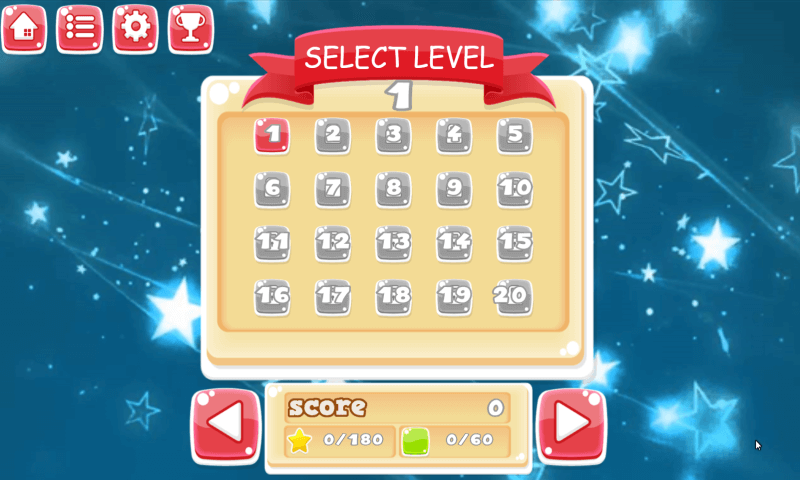
It shows the levels you have finished and the levels you can play. You can play all the green and red levels. The white levels are not available till you finish the ones before.
Once you click the level you want to play, you will see the following:
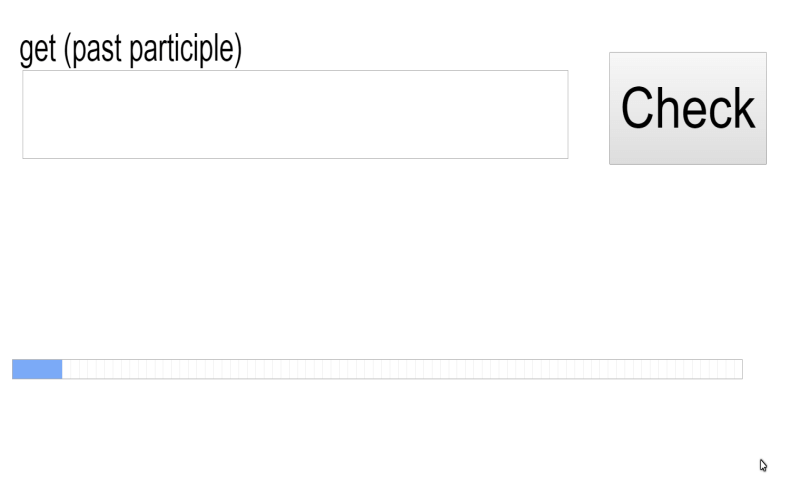
At the top of the screen there is an irregular verb and in the brackets there is written which form you should write. Type the approprite form and click CHECK or ENTER. If your answer is correct, green word correct will appear under your answer. If it is not correct, you will see the red word WRONG and the correct answer below it.
If you answer correctly, the verb will not appear in this level again. If you make a mistake, the word will get repeated once or twice.
Each level contains between 15 and 75 words to learn.
You can find the app in the Google play store by writing 190 Irregular verbs.
I hope you will like this game and that it will help you learn all the irregular verbs.
We live and teach in the communicative era. However, the textbooks offer very few speaking activities where students could practise the language they have learnt. That is why I decided to share several speaking activities with you.
<!– wp:more –>
In this post there are two speaking activities to practise describing a house using the phrases THERE IS/ARE, a simple communicative strategy that helps the learners speak more and a nice set of activities to practise the present simple tense.
ADVERT:
[showmyads]
Describing a house
To practise the phrases THERE IS/ARE I use the following two activities: Draw and describe and Find the difference.
For the Draw and Describe activity print the following worksheet. Each student needs a piece of paper with two houses (one sheet per student).
Draw and Describe worksheet
Students work on their own and draw between 10 and 15 things into their houses. Just remind them that they need to draw things they can name or describe.
Then students work in pairs. They mustn´t show their picture to their partner. They describe their house and the things they have drawn. Their partner listens and tries to draw the things into their empty house.
When they finish the students swap roles. In the end they compare their pictures.
The other activity is called Find the Difference. Print the following worksheet.
Students work in pairs. Each gets one half of the worksheet. One has the part A and the other part B. Students mustn´t show their picture to their partner. They describe the pictures and they try to find as many differences as they can.
In the end they show their picture to their partner and they see whether they managed to find all the differences.
SA + EI
About three months ago I published my first book called 444 Grammar Conversations.There are nearly 500 questions to give students an opportunity to practise grammar in speaking.
However, it often happens that students ask and answer the questions, and they finish the conversation in a few seconds. To prevent this, I found the following communicative strategy: SA + EI.
It might sound scary, but it is really simple. If someone asks you a question, you give a short answer (SA) and some extra information (EI). And the student who asked the original question uses the extra information to ask another question.
For example:
A: Where do you live?
B: I live in Brno. It is a beautiful city.
A: What are the most beautiful places there?
B: I like Spilberk. It is a castle in the centre of the town.
Using this simple strategy, each conversation gets three times longer than before.
Here is a set of questions you could use for this activity:
a) Were you on the internet yesterday?
b) Did you watch TV yesterday?
c) What are you going to do this weekend?
d) Do you like school?
e) Did you learn English yesterday?
f) Who did you speak to yesterday?
Present simple tense – speaking
Print the following worksheet once and cut it. Place the 14 pieces around the classroom.
Print the following text and give it one copy to each student. Tell them to walk around the classroom and find who each paragraph is about. They write the number at the end of the paragraph.
The correct answers are 8,3,11,1,2.
Finish this part after about seven minutes. Tell the students to turn the paper. Give each student an uncut copy of the worksheet Daily Routine Speaking. Students now work on their own and they write a short paragraph about one of the series of pictures. Ask students to use at least two negative sentences, even though they are not necessary.
Students work in pairs. They read their description and their partner guesses who they are talking about. Students swap pairs at least three times.
In the last phase,students choose a series of pictures and just say what the person does every day and their partner must guess who they are talking about. In this part they speak without any preparation.

